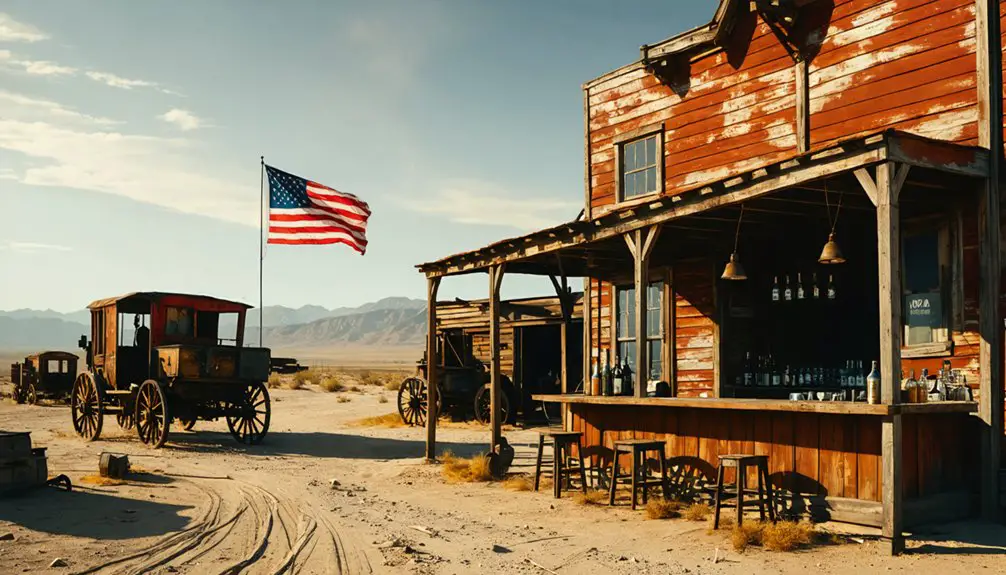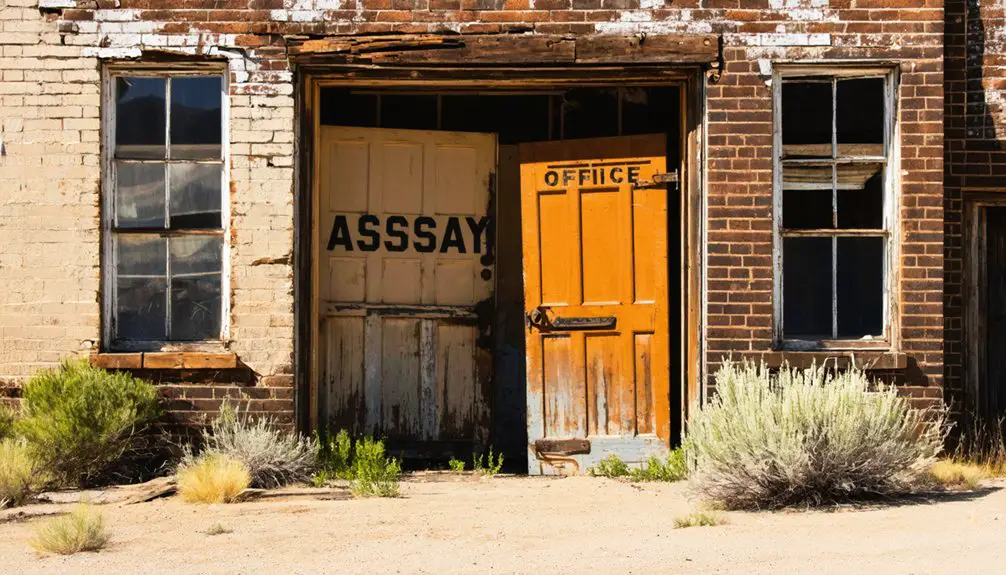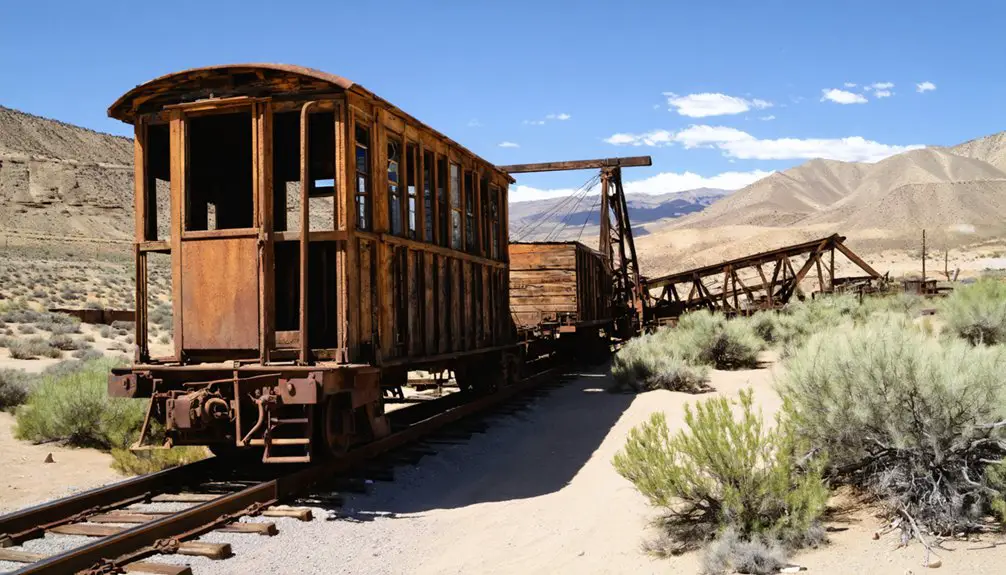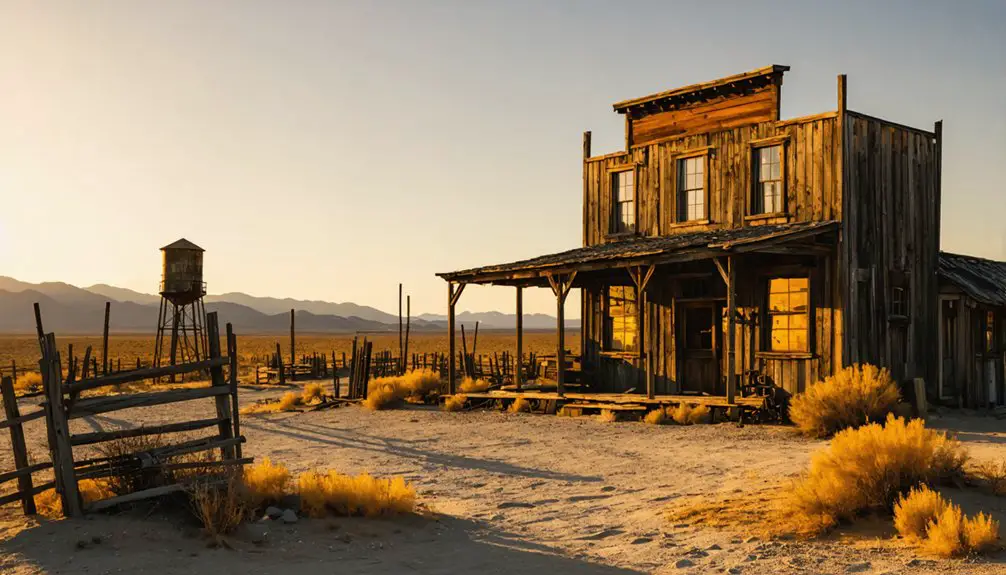You’ll find Gold Bar, Nevada in the historic Bullfrog Hills, where gold was discovered in 1904. The mining town quickly developed around the Homestake Mine, with a ten-stamp mill built in 1907 to process ore worth up to $150 per ton. Despite early promise, the operation lasted only five months before closing in May 1908 due to poor extraction methods and water issues. Today, concrete foundations and steel headframes tell a deeper story of Nevada’s mining heritage.
Key Takeaways
- Gold Bar was established in 1905 following a gold discovery in Nevada’s Bullfrog Hills, becoming a mining town with fifty permanent residents.
- The town’s primary operation, the Homestake Mine, featured a ten-stamp mill that processed three tons of ore daily during peak operations.
- Gold Bar’s decline began in 1908 when poor ore quality and technical difficulties forced the mill to close after only five months.
- Today, visitors can explore concrete mill foundations, steel headframes, wooden shacks, and old saloon ruins at the ghost town site.
- Modern mining operations from 1987 to 1996 extracted 286,000 ounces of gold, confirming the area’s historical significance in Nevada mining.
The Birth of Gold Bar During the Bullfrog Rush
When prospectors discovered rich gold ore in Nevada’s Bullfrog Hills region in 1904, they sparked a mining rush that would lead to Gold Bar’s establishment. The distinctive green ore they found inspired the name “Bullfrog,” attracting intense interest from mining investors across the region.
Following this bullfrog discovery, the Bullfrog Gold Bar Mining Company laid out the townsite in November 1905. Loftus and Davis acquired the mining operation for $117,000 that same year.
You’ll find that early assays showed promising returns between $30 and $150 per ton, drawing further mining investment to the area. The Las Vegas & Tonopah Railroad‘s proximity proved essential for the operation’s development, enabling efficient ore shipment and supporting the town’s initial growth.
This strategic location and the early gold yields positioned Gold Bar as a seemingly promising venture in Nevada’s newest mining district. The town gradually expanded to include fifty permanent residents by January 1908.
Mining Operations and the Homestake Mine
The Homestake Mine emerged as Gold Bar‘s primary mining operation following the initial Bullfrog discoveries. You’ll find that early assays showed promising values between $30-$150 per ton, leading to rapid development under the Bullfrog Gold Bar Mining Company’s management. Originally established in Moses and Fred Manuel prospected for gold in 1876, the company went on to become one of America’s largest mining operations.
The Homestake legacy in Gold Bar proved short-lived, though, as mining challenges quickly emerged. This contrasted sharply with the original Homestake claim in Dakota, which was purchased by George Hearst for $70,000 in 1877.
- A 15-horsepower hoisting engine was installed by January 1906, with the shaft reaching 220 feet deep by March.
- The ten-stamp mill began crushing ore in January 1908, utilizing the Las Vegas & Tonopah Railroad for shipments.
- Operations collapsed by May 1908 due to diminishing ore quality, leading to the company’s dissolution in December.
Despite J.P. Loffus’s later attempts to revive operations, the mine proved worthless, and the mill was dismantled by 1911.
The Ten-Stamp Mill’s Brief Run
You’ll find that Gold Bar’s ten-stamp mill project, announced in January 1907, represented ambitious plans to process the area’s promising gold ore through advanced amalgamation and cyanide treatments.
The mill’s construction faced several setbacks, including delayed water pumps, labor disputes affecting power supply, and problematic pipeline installations, before finally beginning operations in January 1908. One stamp could process approximately three tons of ore during each 24-hour operating period.
Despite initial claims of “immense reserves,” the mill’s run proved remarkably brief, shutting down by May 1908 due to depleted ore supplies and technical difficulties, leading to the company’s collapse by year’s end.
Mill Construction and Installation
During early 1907, ambitious plans emerged for Gold Bar’s mining operations as company officials announced their intention to construct an on-site mill. The mill design included a ten-stamp configuration with amalgamation and cyanide treatment processes, supported by a 50,000-gallon water tank positioned above the site.
Construction challenges plagued the project throughout 1907, primarily due to power line disputes between Nevada-California Power Company and labor unions. Much like the labor disputes in Goldfield, these conflicts significantly impacted construction timelines and overall progress. Despite these setbacks, you’ll find the key developments unfolded in this sequence:
- Building completion and machinery installation by December 1907
- Power connection delays due to union interventions
- Final equipment placement and operational start in January 1908
While the mill’s construction finally reached completion, faulty pipeline installations would later prove problematic, foreshadowing operational difficulties ahead.
Ambitious Processing Goals
Gold Bar’s ten-stamp mill represented an ambitious leap forward in local ore processing capabilities when it began operations in early 1908.
You’ll find the facility was designed to process 40-50 tons of ore daily through ten 905-pound stamps, each delivering 100 drops per minute with a 6-inch fall.
The mill’s operational innovations included a dual processing approach – ore first passed through stamps onto 120 square feet of amalgamation plates, then through a Huntington mill for additional processing. Modern operations at Gold Bar now employ a much more efficient ADR plant throughput of 8,057 tons per day.
While the company initially planned to use cyanidation, they ultimately streamlined operations by focusing on amalgamation.
Despite these advanced features, processing challenges emerged. The lack of reliable electric power delayed full operations, and underground mining had to be temporarily suspended while surface work continued and ore stockpiled for future mill feed. The site has since proven its value, with historical production of 134,000 gold ounces from 1991 to 1994.
Swift Operational Decline
Despite the mill’s advanced design aspirations, its operational reality proved frustratingly brief. The mill’s January 1908 startup, delayed by power line disputes and missing water pumps, marked the beginning of a rapid decline that reshaped local economic impacts and community dynamics.
- You’ll find the mill operated for only five months before depleting ore reserves forced its closure in May 1908.
- The population of 50 residents quickly dispersed as the mill’s shutdown triggered the mine’s closure.
- By 1910, after sitting idle for two years, the mill was sold and relocated to Round Mountain in 1911.
The facility relied heavily on water-fed stamps to crush ore into a workable pulp, following standard practices of the era. The ten-stamp mill’s short lifespan exemplified the volatile nature of frontier mining ventures, as Gold Bar swiftly transformed from a hopeful boomtown into yet another Nevada ghost town.
Daily Life in a Small Mining Community

Life in Gold Bar centered around the demanding rhythms of mining operations, with about 50 residents adapting to basic living conditions by early 1908.
You’d find miners working round-the-clock shifts, living in company-built boarding houses near the mines for convenience. Community survival depended on the mine’s success, with social dynamics shaped by labor relationships and the constant flow of workers. Like other Nevada mining towns, the area experienced dramatic boom-bust cycles throughout its history.
Miners toiled endlessly in shifts, dwelling near the mines, their community’s fate tied to the success of their backbreaking labor.
Your daily routine would’ve revolved around the harsh realities of mining life. While the town provided basic necessities, recreational options were limited. The social structure centered on work relationships, with miners even considering forming their own union local.
When mining operations began to fail, you’d have witnessed the community’s swift transformation as buildings were relocated to nearby Rhyolite, highlighting the transient nature of these frontier settlements.
Decline and Abandonment of Gold Bar
By 1910, the once-promising Gold Bar Mine spiraled into decline as multiple crises converged to seal its fate. Poor gold extraction methods led to significant losses, with $3.60 per ton escaping in tailings while water supply problems crippled operations. Financial mismanagement became evident when Superintendent Bedford’s sudden resignation coincided with a massive stock sell-off of over 200,000 shares.
- Technical failures plagued the operation, with only half the required water reaching the mine and inefficient ore processing methods.
- Corporate leadership abandoned ship as controllers Loftus and Davis fled to Europe during the crisis.
- Legal battles erupted when Nevada Exploitation Company sued for $36,300 in unpaid mill construction costs.
The combination of operational challenges, plummeting share prices, and unresolved disputes ultimately transformed Gold Bar into a ghost town.
Exploring the Ghost Town Today

While Gold Bar‘s mining operations have long ceased, today’s visitors can explore this remote Esmeralda County ghost town through its well-preserved ruins and historic structures.
You’ll find wooden shacks, old saloons, and mining infrastructure that paint a vivid picture of Nevada’s gold rush era. Access requires travel via U.S. Route 95 and smaller state roads, so plan your transportation carefully.
For the best experience, bring your camera to capture the “arrested decay” atmosphere, especially during golden hour. Ghost tours operate in the area, offering chances to investigate paranormal activity.
You’ll discover exceptional stargazing opportunities after sunset. While Gold Bar itself offers minimal facilities, nearby Gold Point and Goldfield provide accommodations, dining options, and visitor centers.
Remember that cell service is limited, so download maps beforehand.
Physical Remnants and Safety Considerations
Scattered across Gold Bar’s rugged terrain, the physical remnants of its mining past present both fascinating historical artifacts and serious safety hazards. Your remnants analysis will reveal concrete mill foundations, steel headframes, and extensive tailings piles that tell the story of large-scale mining operations that ended in 1909.
Today, these industrial ruins demand strict safety precautions from explorers.
- The massive open-pit mine features steep, unstable edges that pose life-threatening fall risks.
- Multiple mineshafts, though secured with metal cylinders, remain extremely dangerous due to their depth and deteriorating conditions.
- Crumbling stone structures and wooden shacks from the early 1900s are structurally unsound and unsafe to enter.
When exploring, you’ll need to watch for obscured drop-offs, loose ground, and scattered debris while staying alert to desert climate hazards.
Gold Bar’s Place in Nevada Mining History

The discovery of Gold Bar during the 1904 Bullfrog rush marked the beginning of a significant chapter in Nevada’s mining history, with initial gold ore values ranging from $30 to $150 per ton.
You’ll find Gold Bar’s historical significance stretches across three distinct periods of gold mining activity, reflecting Nevada’s evolving mineral extraction industry.
While early operations from 1906 to 1911 faced technical challenges and ultimately failed, the site’s true potential emerged in the 1980s.
Modern mining techniques led to impressive production of 286,000 ounces between 1987 and 1996.
Gold Bar’s location within the Battle Mountain-Eureka-Cortez gold trend, one of Nevada’s most productive regions, continues to underscore its importance.
The district’s strategic position near major operations like Ruby Hill and Nevada Gold Mines cements its place in the state’s rich mining heritage.
Frequently Asked Questions
Was Gold Bar Ever Connected to Any Native American Settlements or Conflicts?
You’ll find no direct Native American settlements at Gold Bar, though historical connections show indigenous peoples used the broader region and experienced tensions with miners during the early 1900s mining boom.
What Was the Average Temperature and Climate Like in Gold Bar?
Blazing summers and cool winters define your average weather here. You’ll experience seasonal variations from 100°F+ July peaks to winter lows near freezing, with minimal rainfall throughout the Mojave Desert climate.
Did Any Famous Historical Figures Ever Visit Gold Bar?
You won’t find any famous visitors documented at Gold Bar. Historical significance was limited, with only local mine owners and workers recorded during its brief existence from 1905-1911.
Were There Any Significant Accidents or Deaths Recorded at the Mine?
You won’t find any documented fatal incidents or major safety disasters at this mine. Historical records show operational challenges but no significant accidents, making it particularly different from other Nevada mines.
Did Gold Bar Have a Cemetery, and Does It Still Exist Today?
Despite cemetery discoveries and graveyard legends in nearby mining towns, you won’t find evidence of a dedicated cemetery in Gold Bar. No historical records confirm one existed, and none remains today.
References
- https://travelnevada.com/ghost-town/gold-point-ghost-town/
- https://www.smithsonianmag.com/sponsored/nevadas-living-and-abandoned-ghost-towns-180983342/
- https://nevadamagazine.com/issue/march-april-2019/9313/
- https://www.nvexpeditions.com/nye/goldbar.php
- https://findingnevadawild.com/goldfield-the-old-west-lives-in-nevadas-best-ghost-town/
- https://www.nps.gov/parkhistory/online_books/deva/section4a5.htm
- https://www.legendsofamerica.com/nv-goldbarswindle/
- https://www.mindat.org/loc-8984.html
- https://www.nps.gov/parkhistory/online_books/deva/section4a6.htm
- https://www.goldbarsworldwide.com/PDF/HB_1_Homestake.pdf



